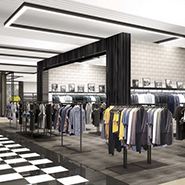- About
- Subscribe Now
- New York,
November 11, 2014

 Men's section of Bloomingdale's in Palo Alto
Men's section of Bloomingdale's in Palo Alto
Consumers are extremely connected through many different digital touchpoints and it is up to retailers to use these opportunities to connect with their clients, according to a new report from IDC.
The report highlights the top 10 critical decisions retailers must make for the upcoming year. It may help luxury brands better understand how they should adjust their initiatives to best accommodate the evolving consumer.
"Digital - physical convergence is undeniable," said Leslie Hand, vice president at IDC Retail Insights, Boston, MA.
"The consumer is mobile and mobility is a part of the shopping journey," she said. "Location based contextualized and personalized interactions will drive higher frequency and basket size.
"The store will also need to provide mobile tools for employees to assist and guide the in store shopper's experience, and to enable important operational efficiencies."
“IDC FutureScape: Worldwide IDC Retail Insights 2015 Predictions – It’s All about Participation Now” summarizes IDC Retail Insights' outlook for 2015 and the 24-month planning horizon. The results are from a scan of the global retail ecosystem to identify critical economic, technology, business, political, environmental and legal developments that are behind the 10 most important decision imperatives facing the industry's IT and LOB technology buyers and influencers.
Futuristic thoughts
Prior to looking at each imperative, decision makers for brands are encouraged to look at each of the 10 items and assess their relevance, urgency and resource requirements.
These 10 imperatives include the shift to third platform technologies, new techniques to be integrated for real-time commerce, line-of-business participation and leadership of IT investment decisions, cyber security analytics, intelligent sourcing and fulfillment, customer experience performance management, product and market place intelligence complementing customer intelligence and new sources to spark loyalty, marketing and promotions.
IDC also looked into the digital identity universe of individuals who are connected to cloud services. The report found that most people have 33 connections to the digital world though channels like email, social media, online publications, ecommerce and more. According to the report, “If just 35 percent of the world population is included in the 'average,' the world wide [digital identity universe] sits at about 80 billion.”
Image from IDC report
However, consumers are increasingly concerned about the control they have over what retailers can learn about them.
"Consumers will demand choice and control in sharing personal data," Ms. Hand said. "Opt in - give to get - relationships are the only way to go.
"The luxury shopper wants a higher level of personalization, only made possible when they opt in to relationship / location based programs, but the luxury brand must honor and protect privacy commitments," she said. "To some degree mobile devices, protected by multi-factor authentication (including biometrics) and tokenized secured data, may seem like the safest way to share data and transact."
The trends in mobile spending are predicted to increase. By 2017, time spent on mobile will be 58 percent more than time spent online on other devices. Also, the number of consumers purchasing non-digital items online is expected to see a 25 percent increase and the number of mobile users purchasing non-digital things will likely increase by 113 percent.
Also by 2017, Internet advertising is predicted to increase by 46 percent. Future mobile ad spending will also focus on other devices than smartphones, such as tablets and ereaders.
As retailers adopt omnichannel experiences, it is more important for them to think about the long term effects of the experience: how the technology can uphold throughout the retailer’s future.
The existing technology in social, mobile, cloud, big data and analytics will add to future developments to help enhance the retailer’s options. Having the ability to run analytics and critical decision cycles often will let retailers see their statistics regularly and keep their consumers happy with the most up-to-date ideas and services.
In the next one or two years, it is suggested that retailers invest in consumer based changes, provide associates with training and needed tools for the best consumer experience and new technology for better experiences.
Best of both worlds
Physical and digital campaigns can no longer be separate, but must instead be intertwined to attract the attention of consumers on multiple platforms, according to a session Nov. 5 at ad:tech New York 2014.
According to the “Physical and Digital = The New Creative Palette” panel, the integration of the physical and digital will result in higher rates of consumer interaction for a particular campaign. The recipe for combining the two platforms can be complicated, but with the right amount of action from each side, brands can find the balance between the physical and digital (see story).
The integration of the physical, in-store experience, with the online or mobile campaigns present from the store is crucial for retailers to reach the evolving consumer.
For instance, department store chain Bloomingdale’s opened its first fully mobile store in Palo Alto, CA, to appeal to the “digitally sophisticated” tech community in Silicon Valley.
Featuring smart dressing rooms, mobile checkout, consumer-facing tablets and sales associates armed with mobile devices, the store in the Stanford Shopping Center heightens the omnichannel experience for shoppers. This neighborhood is a good testing ground for new retail technologies, which Bloomingdale’s may want to carry over to other locations (see story).
The combination of physical and digital can lead to improved consumer relations.
"Luxury retailers do not get a pass on mobile," Ms. Hand said.
"In fact, the luxury customer expects superior service and special service enabled by mobile - not in place of personalized human interactive experiences, but enhancements that enable even better service," she said. "Can a personal shopper greet me when I enter the store? Can it be digitally, so that needs can be addressed in advance of my arrival?"
Final Take
Nancy Buckley, editorial assistant on Luxury Daily, New York
Share your thoughts. Click here